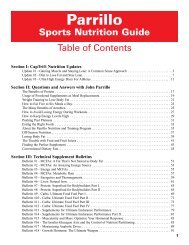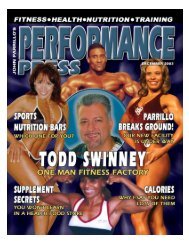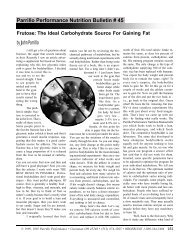Performance Press / June 2011 - Parrillo Performance
Performance Press / June 2011 - Parrillo Performance
Performance Press / June 2011 - Parrillo Performance
Create successful ePaper yourself
Turn your PDF publications into a flip-book with our unique Google optimized e-Paper software.
JOHN PARRILLO’S PERFORMANCE PRESS<br />
If you’ve checked out our<br />
products lately, you know<br />
we’ve got pancakes, muffin<br />
mix, cake mix, frosting, bars in<br />
flavors like sweet milk chocolate,<br />
and more. It’s almost like we’re<br />
running a sweet shop than a supplement<br />
store. Our “sweets” are<br />
supplements, and they’re sugarfree.<br />
Okay, what’s wrong with sugar?<br />
Some say it’s “natural,”<br />
since it comes from the sugar<br />
cane plant. But calling this refined<br />
white stuff “natural” is<br />
sugarcoating the facts. In modern<br />
sugar cane farming, chemical<br />
fertilizers and pesticides<br />
are used to grow the sugar cane<br />
plants. The mature sugar cane<br />
is harvested and sent to refining<br />
factories, where the cane’s<br />
vitamins, minerals and other<br />
nutrients are separated from<br />
the sucrose. After further refining,<br />
the cane juice is dried,<br />
processed into crystals and<br />
bleached to remove its naturally<br />
dark color.<br />
Refined white sugar has been<br />
linked to dental cavities, increased<br />
cholesterol levels, heart disease,<br />
hypoglycemia, diabetes, obesity,<br />
osteoporosis and nutritional deficiencies.<br />
Additionally, white sugar<br />
can create dramatic fluctuations in<br />
blood sugar which, over time, can<br />
wear down both the pancreas and<br />
the adrenal glands. And because<br />
it provides no nutrition, most dietitians<br />
agree that white sugar has<br />
no legitimate place in a healthy<br />
diet. Researchers suggest our bodies<br />
need only about a teaspoon of<br />
sugar daily for basic metabolic<br />
Research suggests simple<br />
sugars can decrease the body’s<br />
sensitivity to insulin and boost<br />
the production of triglycerides<br />
and bad cholesterol, increasing<br />
the risk of heart disease,<br />
diabetes, and obesity.<br />
functions--and that teaspoon can<br />
be found easily in vegetables and<br />
whole grains.<br />
In reality, most of us take in more<br />
than 20 teaspoons a day, in the<br />
form of snacks, soft drinks, and<br />
“hidden” sugars like corn syrup in<br />
breads and salad dressings. These<br />
are empty calories-offering no nutrients<br />
other than carbohydrates.<br />
Research also suggests ingesting<br />
simple sugars such as sucrose,<br />
fructose, and glucose can decrease<br />
the body’s sensitivity to insulin<br />
and boost the production of triglycerides<br />
and bad cholesterol,<br />
increasing the risk of heart disease,<br />
diabetes, and obesity.<br />
Obviously, you want to shun<br />
this white devil at all costs.<br />
Through expert food engineering,<br />
we’ve been able to bring<br />
you all your favorite treats but<br />
without the fat-forming sugar.<br />
How do we do it? Primarily<br />
with three high-quality sweeteners.<br />
Here’s the scoop:<br />
Erythritol<br />
Erythritol is a “sugar alcohol.”<br />
That name is a bit of a misnomer,<br />
as it is neither true sugars<br />
nor alcohol, but it does add<br />
sweetness to foods for only 0.2<br />
calories per gram compared to<br />
4 calories per gram for sucrose<br />
(table sugar).<br />
Erythritol occurs naturally in<br />
foods such as grapes, pears and<br />
watermelon, as well as fermented<br />
products like wine, cheese and<br />
HOW SWEET IT IS<br />
soy sauce. It is produced commercially<br />
using a natural fermentation<br />
process.<br />
Erythritol not only tastes good<br />
by itself, it also has beneficial effects<br />
when combined with other<br />
low-calorie sweeteners, making<br />
the sensory profile more like<br />
that of sucrose. (Some of our<br />
products combine erythritol with<br />
sucralose.)<br />
Because erythritol is a<br />
smaller molecule than<br />
other sugar alcohols, it is<br />
well absorbed in the upper<br />
digestive tract, providing<br />
the highest digestive tolerance<br />
of all sugar alcohols.<br />
So erythritol doesn’t cause<br />
the gastric distress like all<br />
other sugar alcohols. Further,<br />
since the body doesn’t<br />
convert erythritol to energy<br />
or fat, it contributes almost<br />
no calories.<br />
The bacteria in your mouth<br />
can’t use sugar alcohols for<br />
food, so they don’t contribute<br />
to tooth decay, as<br />
sugar or starch does. Sugar alcohols<br />
actually inhibit the growth<br />
of oral bacteria and are common<br />
ingredients in sugarless mints and<br />
chewing gums. The FDA has even<br />
approved a health claim for labels<br />
that states sugar alcohols do not<br />
promote tooth decay.<br />
A sugar alcohol is 60 to 70 percent<br />
as sweet as sugar with a slight<br />
cooling effect in the mouth.<br />
You can even cook with erythritol<br />
yourself. Use in place of sugar. It<br />
can be used in baking, although it<br />
doesn’t caramelize like sugar.<br />
Brown Rice Syrup<br />
Brown rice syrup has a mildly<br />
sweet, delicate flavor and is processed<br />
by the body more slowly<br />
than white sugar – which is why<br />
we use it as a sweetener in our<br />
bars. The rich butterscotch taste<br />
of this syrup, derived from cooked<br />
Keep refined white sugar<br />
out of your diet!<br />
brown rice, mixes well with our<br />
protein, oat bran, and crisp rice in<br />
our bars.<br />
Sucralose<br />
Sucralose is made from sugar but<br />
isn’t recognized by the body as a<br />
sugar or a carbohydrate, so it isn’t<br />
metabolized.<br />
Sucralose stays sweet at high temperatures,<br />
so it can be used for<br />
cooking and baking. Or simply<br />
use one of our <strong>Parrillo</strong> cake mixes<br />
instead.<br />
In many publications, it has been<br />
inaccurately and irresponsibly suggested<br />
that sucralose has not been<br />
thoroughly studied and that it may<br />
pose a health risk. Such comments<br />
have no foundation in sound science<br />
and serve only to confuse and<br />
unnecessarily alarm consumers. It<br />
is important to know the facts.<br />
Since its introduction over a decade<br />
ago, millions of people<br />
have safely enjoyed<br />
products made with sucralose.<br />
Sucralose has been<br />
tested at extremely high<br />
doses in long-term studies<br />
without any adverse health<br />
consequences. It is one of<br />
the most tested food ingredients<br />
ever introduced,<br />
and its safety has been<br />
confirmed by regulatory<br />
authorities in more than 80<br />
countries. An extensive database<br />
of scientific research<br />
demonstrates sucralose has<br />
no harmful effects and is<br />
safe for everyone, including<br />
sensitive populations<br />
such as people with diabetes,<br />
children and pregnant<br />
women. Feel comfortable<br />
using products with Splenda – as<br />
well as the other sweeteners I’ve<br />
discussed.<br />
All of these sweeteners can be a<br />
key part of a healthy diet and a<br />
means to help reduce added sugar<br />
consumption and calories.<br />
18 <strong>June</strong> <strong>2011</strong> / <strong>Performance</strong> <strong>Press</strong> 1-800-344-3404 www.parrillo.com www.parrillo.com 1-800-344-3404 <strong>Performance</strong> <strong>Press</strong> / <strong>June</strong> <strong>2011</strong><br />
19
















